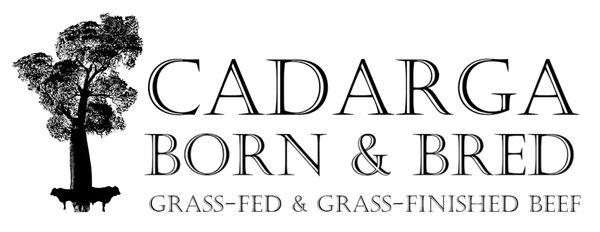Cadarga Born & Bred – Grass-Fed, Grass-Finished, Family-Farm Beef in Queensland
When you choose where your beef comes from, you’re choosing more than flavour. You’re choosing farming practices, local communities, and the long-term health of the land that feeds us all.
At Cadarga Born & Bred, we believe that good beef starts with healthy pasture, clean sunlight, slow growth, and a genuine respect for the land. Our cattle are grass-fed and grass-finished on open Queensland pasture, raised the way nature intended.
And that choice isn’t just good for your plate.
It’s good for the soil, the environment, and the future of farming in Australia.
What Sustainable Grass-Fed Farming Really Means
“Sustainable” gets thrown around a lot — but to us, it has a clear meaning:
-
Cattle that are free to roam on rotating pastures
-
Soil health that improves over time, rather than degrades
-
Farming that gives back to the land
-
Local food systems that support Queensland families
We farm in a way that protects what we have, instead of pushing the land past its limits.
This is the opposite of large-scale feedlots, overstocking, or grain-finishing operations.
Grass-fed and grass-finished farming is naturally aligned with the rhythm of the land — seasons, rainfall, regrowth, and recovery.
Why Grass-Fed Beef Supports the Environment
Healthy grasslands are one of the most powerful carbon sinks on the planet.
When managed well, pasture absorbs carbon from the atmosphere and locks it into the soil.
Our rotational grazing approach means:
-
Pasture isn’t eaten down to bare soil
-
Grass has time to regenerate
-
Soil organisms thrive
-
Carbon is captured and stored — not released
This leads to:
✔ Stronger root systems
✔ Better water retention (important for Australian drought cycles)
✔ Improved biodiversity
✔ More resilient farmland for future generations
Sustainable farming isn’t a buzzword, it’s an investment in tomorrow.
A Calm, Natural Life = Better Beef
We raise cattle slowly, with low-stress handling, and no unnecessary intervention.
This isn’t just better ethically but it also affects the quality of the meat.
Cattle that live calm, natural lives produce beef that is:
-
Fuller in flavour
-
Naturally tender
-
Higher in Omega-3 fatty acids
-
Rich in vitamins, minerals and CLAs
-
Lower in saturated fats than grain-finished beef
This is real beef, not factory-farmed, not rushed, not forced.
It tastes like the paddock, the seasons, and the care behind it.
Taste the Difference of Paddock-to-Plate
When you buy from Cadarga, you’re buying:
-
Directly from the family who raised your beef
-
From land we personally steward and protect
-
Beef that is traceable, transparent, and honest
Everything we produce is:
-
Butchered locally
-
Meal packed
-
Labelled and freezer-ready
-
Delivered across South East Queensland & Northern NSW
We offer Quarter, Half and Whole Beef Shares, making it easy to keep your freezer stocked with premium, farm-direct grass-fed beef all year round.
Why Local Matters More Than Ever
Every time you choose local, Australian, family-farm beef, you:
-
Support rural farming families
-
Strengthen regional food systems
-
Reduce long-distance transport emissions
-
Keep money circulating in Queensland communities
-
Help protect farming land from foreign buyout or industrial misuse
Choosing local is a direct investment in our region’s future.
And your future dinner plates.
Want to Eat Sustainably, Seasonally, and Locally?
Explore our next delivery runs, secure your beef share, or learn more about how we farm:
cadargabornandbred.com.au
Good beef starts in the paddock.
Good farming starts with care.
And good choices start with people like you.
Thanks for being part of the future of Australian farming.
Born here. Raised here. Enjoyed here.
Cadarga Born & Bred
Queensland Grass-Fed Beef • Family Farm • Ethical • Sustainable • Paddock to Plate

